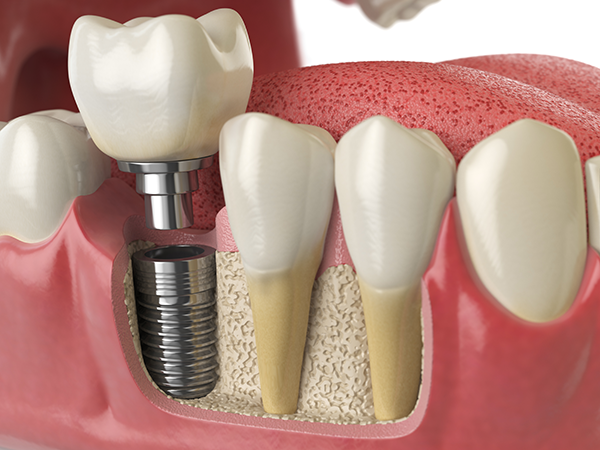Phoenix Oral & Facial Surgery Dental Implants
 Dr. Alexander Kim has advanced training in the placement of dental implants for patients in the Phoenix community. Our goal here at the Phoenix Oral & Facial Surgery is to provide a new standard of care in creating exceptional results with minimal discomfort. We will work closely with your restorative dentist to create a highly aesthetic and functional result.
Dr. Alexander Kim has advanced training in the placement of dental implants for patients in the Phoenix community. Our goal here at the Phoenix Oral & Facial Surgery is to provide a new standard of care in creating exceptional results with minimal discomfort. We will work closely with your restorative dentist to create a highly aesthetic and functional result.
Replacing a Missing Tooth
A natural tooth is anchored into the jawbone by its tooth root. Tooth roots should be attached firmly to the bony jaw and keep your teeth stable when chewing or eating.
Traditionally, if a patient was missing a tooth or if one needed to be removed, the healthy teeth on either side of the missing tooth would be cut down to secure anchors for a dental "bridge".
Dental implants are the modern alternative. Instead of cutting down two perfectly healthy teeth, Dr. Kim will surgically place a dental implant into the jaws to replace your missing tooth root. This implant then heals and becomes anchored or "integrated" into your jaw like a natural tooth root. Once this healing is complete, your restorative dentist will place a crown onto your artificial root that looks, feels, and functions like a natural tooth.
Quite simply, dental implants are the best and most natural replacement for missing teeth.
Replacing Several Missing Teeth
Traditionally, several adjacent missing teeth would have been replaced with a removable denture or a long span bridge. However, these older methods of dental treatment have many disadvantages. Dentures have to be taken out to clean and soak at night. During the day, they can be painfully uncomfortable and move when attempting to talk or eat. Dentures also make it difficult or impossible to eat certain foods. Similarly, an extensive dental bridge puts significant pressure on the anchor teeth that are used necessitating caution and significant limitations with chewing and diet. Fracture of an anchor tooth would mean not only loss of the bridge prosthesis but also further loss of function in that area.
Dental implants can now be used to anchor complete dentures to prevent the slipping, irritation, and pain associated with "floating" dentures. It may also prevent the tedious removal of dentures for overnight soaking and cleaning. Dental implants would also eliminate the need for dental adhesives and allow you to enjoy eating the foods you previously avoided. With dental implants, your dentures are firmly anchored to the jawbone, causing them to feel and function much more like natural teeth.
Since natural tooth roots and integrated dental implants are anchored firmly in your jawbone, both will stimulate the bone and prevent it from melting away or resorbing when you chew. You may know people who appear prematurely old after losing their teeth because their jawbone had melted away after wearing traditional dentures. Dental implants help preserve your jawbone and appearance.
The Success Rate of Dental Implants
Dental implants have a high rate of predictable success. After their healing period, the success rate of implants is typically between 94% and 98%. If you are a non-smoker with good oral hygiene, the percentage may be even higher.
Advanced Dental Imaging
One key to dental implant safety and success is through the use of advanced imaging. Digital scanning with Cone Beam CT, or CBCT, allows us to take three-dimensional, high-resolution CT scans of your facial anatomy. We can then view these images from different angles, take precise measurements, and share this data with other doctors or a dental lab. A CBCT ensures that every possible precaution has been made to reduce the risk of complications during surgery by avoiding nerves in the lower jaw and the sinuses and nose in the upper jaw.
Until recently, CT scans were only performed in hospitals or medical facilities. Our office is one of the very few in the United States with the latest in digital CT scanning. To read more about the advanced dental imaging we use, click here.

